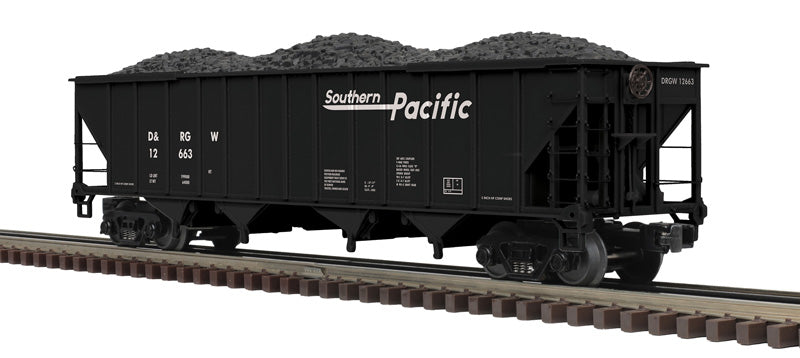Resources
About & Contact Us


Atlas O 3001287 - Premier - 4-Bay Coal Hopper "Southern Pacific"
- Sale price
- $ 76.46
- Regular price
- $ 84.95
- You save
- $ 8.49 (10%)
Announcement Date:
Guaranteed Pre-Order Due Date:
Expected Delivery Date:
Individually Boxed:
Product Information
| Announced Date: | Oct 2022 |
| Released Date: | Jan 2024 |
| Individually Boxed: | No - 4 to a case |
- Road Name: Southern Pacific
- Road Number: 12663, 12669
- Product Line: Premier
- Scale: O Scale
- System: 3-Rail
Features:
- Intricately Detailed, Durable ABS Body
- Detailed Coal Load
- Metal Wheels and Axles
- Die-Cast 4-Wheel Trucks
- Fast-Angle Wheel Sets
- Needle-Point Axles
- (2) Operating Die-Cast Metal Couplers
- O Scale Kadee-Compatible Coupler Mounting Pads
- Detailed Brake Wheel
- Separate Metal Handrails
- 1:48 Scale Dimensions
- Unit Measures: 13 1/4” x 2 5/8” x 3”
- Operates On O-31 Curves
Overview:
This car is likely the last hurrah of the bottom unloading coal hopper. Its prototype was built largely in the 1960s and ‘70s, just before the destinations for these cars — mainly utility power plants and harbor side shipping facilities — began switching to rotary unloading. While many of these cars survive in service today, newer coal cars are technically not hoppers at all. With trough-like bottoms and no hopper doors, they’re actually high-sided gondolas designed solely for rotary unloading.
Unlike equipment that carried a variety of loads, like boxcars, flatcars, and gondolas, the “sawtooth” style coal hopper was designed in the late 1800s specifically for one purpose: transporting coal from mines to customers. Its capacity matched the volume of coal that a pair of typical freight trucks could carry. And its slope sheets — the angled floors at either end of the car — were set at precisely the angle at which coal would flow easily from its bottom doors. (Covered grain hoppers, for example, require much steeper slope sheets.)
The earliest steel hoppers were generally 2-bay, 50-ton cars. As truck capacities increased, the 3- and 4-bay 70-ton car became common. These larger cars generally delivered softer, dirtier burning bituminous coal to industrial clients and the railroads themselves. A revision of axle ratings by the Association of American Railroads (AAR) in 1963 paved the way for 100-ton cars like this model, the final evolution of more than seven decades of coal hopper design.
We Accept
Recommended for You
Browsing history
- Choosing a selection results in a full page refresh.
Get in touch
177 W Main St
Atlanta, IN 46031
765-292-2022
support@mrmuffinstrains.com
Keep in Touch
Sign up for our newsletter and be the first to know about coupons and special promotions.
Country/region
© 2025, MrMuffin'sTrains Powered by Shopify
